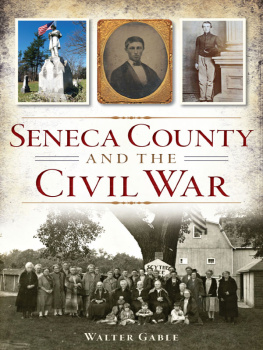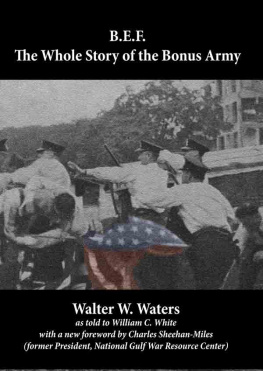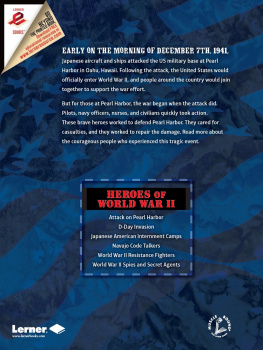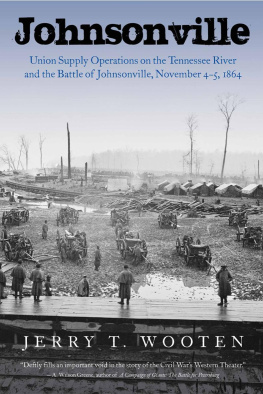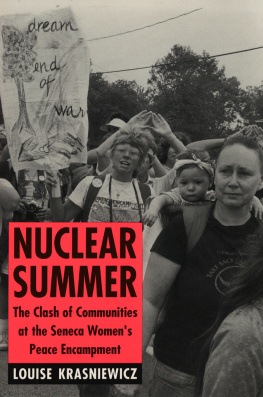
Published by The History Press
Charleston, SC 29403
www.historypress.net
Copyright 2012 by Walter Gable and Carolyn Zogg
All rights reserved
First published 2012
e-book edition 2012
Manufactured in the United States
ISBN 978.1.61423. 757.0
Library of Congress CIP data applied for.
print ISBN 978.1.60949. 820.7
Notice: The information in this book is true and complete to the best of our knowledge. It is offered without guarantee on the part of the authors or The History Press. The authors and The History Press disclaim all liability in connection with the use of this book.
All rights reserved. No part of this book may be reproduced or transmitted in any form whatsoever without prior written permission from the publisher except in the case of brief quotations embodied in critical articles and reviews.
CONTENTS
PREFACE
How ironic that Ken Burns documentary The War is being rebroadcast by Public Television just as this book readies for press. Scenes and news clips of German submarines in New York Harbor, its city residents uncooperative with the government-requested blackoutsThis was the scene in 1941, before Pearl Harbor, when not many upstaters, including Seneca County farmers, took notice of Nazi and Japanese aggression coming to their land. Communication was slow, and survival of the Great Depression was the order of the day.
Watching The War unfold makes me take another look at Seneca Army Depot, the text that Walt and I are producing. How does 11,000 acres of farmland come to be earmarked for a munitions depot, confiscated by the Department of War with such speed and swiftness that it produced its own war-like destruction? Citizens, led to believe in their countrys patriotism, had to cooperate and leave their ancestral homes and land. Bulldozers took over, flattening houses and barns and trees and flowering shrubs. Burning was everywhere, similar to General Sullivans routing of the American Indians, through the same lands, destroying people and peach trees. Did the government know it desperately needed to prepare for war, quickly, yet in secrecy? Had it known its citizens would not believe war was coming across the Atlantic, the Pacific?
This book is a little-known story of how and why government action changed the fabric of a land and its people. A land long-known for its ability to change the world, with the Womens Rights Movement, the beginning of Mormonism, the Underground Railroad, the Vote for Women.

Note the location of Seneca County within New York State. Courtesy of Michael Karpovage.
It is my hope that making this small piece of history, researched and written by Walt Gable, available for anyone to read or listen to, will make us think of our government and its actions, how our government affects us every day, how we act or react.
In Seneca Falls, New York, 1997, Ken Burns was filming Not for Ourselves Alone, the story of Elizabeth Cady Stanton and Susan B. Anthony. He was asked to speak with a number of 4th graders gathered at the Stanton House about his work. He ended his remarks by saying, Our past is our greatest teacher. May our past be our greatest teacher as we learn more of what was happening in our backyard in the years between 1941 and 2011. May we think that those who follow will gather insight and learn from our past.
Carolyn Zogg
INTRODUCTION
From World War II through Project Desert Storm, the Seneca Army Depot in mid-Seneca County, New York, was a major supply base for the army. It had been established by the War Department in 1941 to help provide defense against possible enemy attack of the northeast Atlantic coast. As quickly as possible, a few hundred munitions storage igloos were constructed. Following formal United States entry into World War II, the work of the Seneca Ordnance Depot (its original name until August 1962 when it was changed officially to the Seneca Army Depot) expanded into being a major supply and storage facility. At the end of that war, this depot continued in that role. It also became a major facility for IPEindustrial plant equipment maintenance. Starting in the mid-1950s, the depot took on an additional rolestorage of special weaponsin its North Depot Activity. In 1983, the depot carried on its work throughout a summer and fall marked by anti-nuclear weapons demonstrations that were reported nationwide. The demise of the Cold War led to the end of storage of special weapons at this depot. Following that downsizing in operations, the Seneca Army Depot was formally closed as an active base in 2000.
In November 2010, a group of local historians meeting with Seneca County Historian Walter Gable decided they wanted to do something in 2011 to mark the seventieth anniversary of the establishment of the depot in 1941. A three-part series of public programs was presented. Much research was done for these presentations. Over twenty individuals were interviewed. The group of local historians decided that we had gathered so much information that we needed to publish a book. The information presented in this book tells much of the big picture of the story of the former Seneca Army Depot, some of which many local residents had very little specific knowledge. Even more importantly, through the interviews conducted, we get some real insights into both the day-to-day operations of this military facility and the profound role of this supply base.

Note the location of the former Seneca Army Depot in mid-Seneca County. Courtesy of Michael Karpovage.

Note the location of the munitions igloos of the depot, the Q area where the special weapons activity took place, as well as the location of new operations on the former depot. Courtesy of Michael Karpovage.
The seventieth anniversary of the establishment of the Seneca Army Depot was celebrated in other ways, thanks to the work of this group of local historians. One of these was a visit to the cemetery of the First Baptist Church of Romulus (locals refer to the church as the Kendaia Baptist Church) on the former depot property. When the War Department forced property ownersincluding that churchto sell their properties to make way for the Seneca Ordnance Depot, it promised that this cemetery would be preserved and that people would continue to have access to it. For years, the public has been allowed to visit the cemetery on the Sunday of Memorial Day weekend. So, on May 29, 2011, the group of local historians placed a wreath at the cemetery. In his brief remarks, Gable pointed out how the federal government has kept its promise about the continued existence of this cemetery.

Several individuals and organizations donated the funds for this historic marker to honor the families that were dispossessed from their properties. Courtesy of Walter Gable.
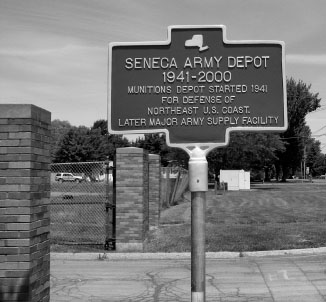
Next page

